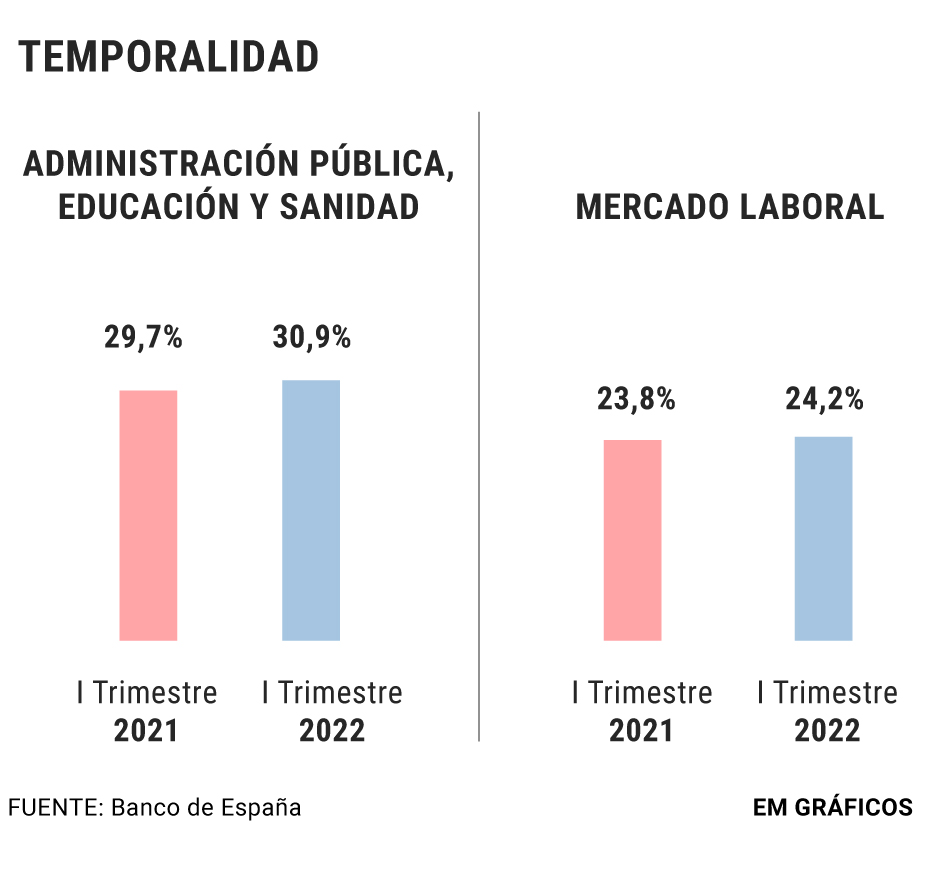The changes introduced by the labor reform in the Spanish labor market to reduce the temporary nature of contracts are increasingly visible, although the speed of the transformation is advancing at different rates.
The new framework fully entered into force on March 31 and already in the data collected by the National Institute of Statistics (INE) it is evident that
permanent hiring is growing and temporary hiring
is decreasing , which with the new regulation is reduced to very justified cases .
The brake on the abuse of temporary contracts was the axis on which the consensus for the labor reform was amassed last December.
Sectors such as construction have had to quickly adapt to the new legal framework, with the disappearance
of the work and service contract
that they used so much to be replaced by indefinite ones in the discontinuous fixed modality, which allows alternating periods of activity and inactivity.
The result is that temporary employment, which until last year dominated the signing of new contracts in a ratio of nine to one and which has been associated with a precarious employment situation in Spain, is receding.
What is striking is that private companies are the ones that are undertaking the change in a much more determined way than the public sector, which, after all, is the one that promotes ending temporary employment and, nevertheless, continues to increase it.
The
Bank of Spain
dropped it yesterday in its analysis of the EPA data, noting that the Spanish temporary ratio stands at 24.2%.
"The quarterly decrease in the temporary employment ratio was concentrated in the market economy, down to 21.8% of wage earners, 1.9 percentage points below that observed at the end of last year. On the contrary, this ratio in non-market services - which, in addition to the Public Administration, includes the Education and Health sectors
- continued to increase, up to 30.9%
".
It is just the opposite trend to that indicated by the new labor market framework.
The difference with the private sector (21.8%) would be close to 10 percentage points with the labor reform already in force.
Temporary hiring in the Public Administration is led by the regional area
and has been one of the reasons why the general figure for this type of hiring in Spain is so high
.
In fact, with Construction being the sector that has clearly dominated the use of work and service contracts in Spain, the Public Administration figures prominently in these contracts, especially in the case of young employees, according to a report prepared for
Esade by Ángel Martínez Jorge and Carlos Victoria.
The same reason, that of excessive temporary employment in the public sector, has been pointed out by the European Commission as one of the aspects in which the labor reform must give results.
In this sense, the civil servants union
CSIF indicated yesterday that the net rate in the sector amounts to 32.4%
and warned that public administrations have only one month (June 1, 2022) to publish public employment offers with the to renew their templates with less temporary and more permanent contracts.
CSIF precisely drew attention to the needs of the health sector, which is one of the areas where the workforce adjustment has focused once the Covid-19 crisis has been overcome.
The alteration caused by the lack of control of prices in the final stretch of 2021 and the first quarter of 2022 has taken its toll on the labor market, which seems to have been infected by the doubts and nervousness that dominate the rest of the economy.
Between last January and March, the improvement experienced throughout 2021 suffered a sudden halt in the first quarter of the year that resulted in the destruction of more than
100,000 jobs
, according to data from the Active Population Survey prepared by the National Institute of Statistics (INE)..
Despite the fact that the figures recorded in the last year continue to be clearly positive as a result of the recovery from the pandemic crisis, the outbreak of the
war in Ukraine
and the
energy and price crisis
that has occurred stopped the improvement of one of the markets most problematic workplaces in the European Union.
The first quarter of the year is usually more negative than the subsequent ones in terms of job creation, but between January and March unemployment rose by
70,900 people
, which is almost
2.3% more than in the previous quarter
, while employment
it was reduced by 100,200 jobs
(-0.5%), its smallest decrease in a first quarter since 2019, when 93,400 jobs were destroyed.
At the end of March, the total number of unemployed stood at 3,174,700 people and that of employed people, at 20,084,700 people, with which the unemployment rate stood at 13.6%, without showing signs of great progress to reduce the gap with a European average that is almost double.
By sectors, the INE data shows that in the last quarter the loss of momentum has been felt above all in activities related to
services, industry and agriculture
.
Construction, which is going through a period of reactivation with unmet needs for workers and pending the rise in prices of basic materials, was the exception.
Conforms to The Trust Project criteria
Know more
INE
Ukraine
European Union
European Comission
ERTE
Employment

